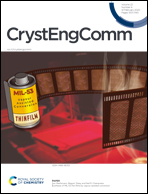Synthesis of MIL-53 thin films by vapour-assisted conversion†
Abstract
A simple method for the preparation of MIL-53 thin films is reported. By employing a vapour-assisted conversion (VAC) approach we were able to prepare homogeneous MIL-53 films on a variety of glass, silicon or alumina substrates. Our strategy uses a vessel that allows film growth in an environment with a solvent-saturated atmosphere, in this case DMF. The VAC preparative conditions lead to the formation of a homogeneous film of the MOF and avoids the formation of alternative aggregates, such as starting materials. The effect of reaction temperature and time are investigated allowing identification of the optimum conditions to produce good film quality.



 Please wait while we load your content...
Please wait while we load your content...